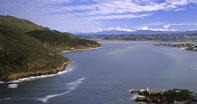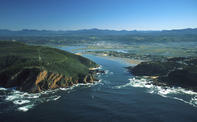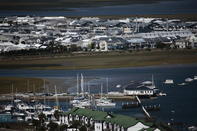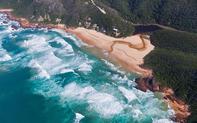Early Settlers in Knysna
The history of Knysna begins with a handful of Dutch settlers who hacked their way through the forests and established farms in the region. The farm Melkhoutkraal, which included the entire Knysna lagoon basin and the Heads, was first granted to Stephanus Terblans in 1770.

But it was George Rex who really put Knysna on the map. This larger-than-life personality bought the Melkhoutkraal farm in 1804. He had arrived in the Cape during the first British occupation, married a widow with several kids and went on to hold a number of impressive, but minor, administerial posts with the British government.
When the Batavian regime took over in 1803, Rex decided to ignore the change in the country’s ownership and stayed on in South Africa. By all accounts, George Rex was a moody man, although he was certainly well-educated and articulate. He could also be a right quite brash, as some of his colleagues would testify, but his humour and hospitality were legendary. His personal history, however, was what made him the stuff of legend.
When George Rex grew tired of the Cape Town high-life, and he relocated to Melkhoutkraal in Knysna where he built a homestead fit for the illegitimate son of a king. From his huge estate, Rex and his progeny kept themselves busy by farming, hunting and cutting down trees. Rex also started agitating for the government (by now under British rule) to establish a harbour inside the Knysna lagoon. This would get around the logistical difficulties of building a road through the thick forests that swaddled the coast, and help Knysna become economically viable.
Knysna Heads

The problem with the harbour idea in the Knysna Lagoon was that the currents which roared through the Knysna Heads were very fierce (and they still are). This narrow channel, flanked by the two tall sandstone sentinels of the Heads, separates the placid waters of the lagoon from the wild, open sea. So, any boats that wanted to anchor in the calm, expansive estuary first had to run the formidable gauntlet of the Knysna Heads.
In 1817, after endless nagging by George Rex, the British navy sent a ship to try and navigate the passage through the heads. The experiment was not a success as the vessel hit a submerged reef and had to be run aground. A second ship was sent to salvage the first ship, and this one did manage to get through the Heads safely.
Rex was delighted, and he donated some land for a shipbuilding yard. He also built a slipway, in expectation of all the boats that would be launched into the lagoon, but the shipbuilding enterprise failed.
From Farmlands to Thriving Village

Eventually, Knysna did get its port, and it was declared a village in 1825. The town wasn’t named after the ruling British governor - instead, it retained its original Khoikhoi name, which is thought to translate as ‘place of wood’. In 1928, a standard gauge railway line from Knysna to George was completed, and this helped precipitate the closure of the Knysna port in 1954.
After presiding over the growth of his town from farmlands to thriving village, George Rex died in 1839 and was buried on the ground of his beloved Melkhoutkraal. His grave can still be visited and is signposted from the main road, just outside of town, towards Plettenberg Bay.
Natural Beauty of Knysna

The once-abundant natural beauty of Knysna has actually been heavily compromised by the rampant development of the town. Houses are being built further and further up the mountain slopes, and the vast informal settlement grows. One of the Knysna Heads is thoroughly pockmarked with over 100 large holiday homes, and this has destroyed much of its wild beauty. Ironically many of these houses were destroyed in a raging forest fire in 2017.
The Western Head is part of the Featherbed Nature Reserve and is the private property of William Smith, the well-known television educator and scientist. Smith’s family has a long association with Knysna and back in the 1950s, his father was the first Western scientist to identify the coelacanth, a prehistoric fish long thought extinct, in Knysna.
By David Fleminger For holiday-makers in search of the dichotomy of relaxation and adventure can rest assured that accommodation in Knysna on the Garden Route ...
For holiday-makers in search of the dichotomy of relaxation and adventure can rest assured that accommodation in Knysna on the Garden Route ... Knysna lies on the banks of a tranquil lagoon, guarded at its mouth by The Heads and overlooked to the north by the Outeniqua Mountains....
Knysna lies on the banks of a tranquil lagoon, guarded at its mouth by The Heads and overlooked to the north by the Outeniqua Mountains....